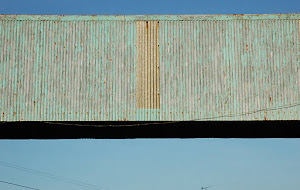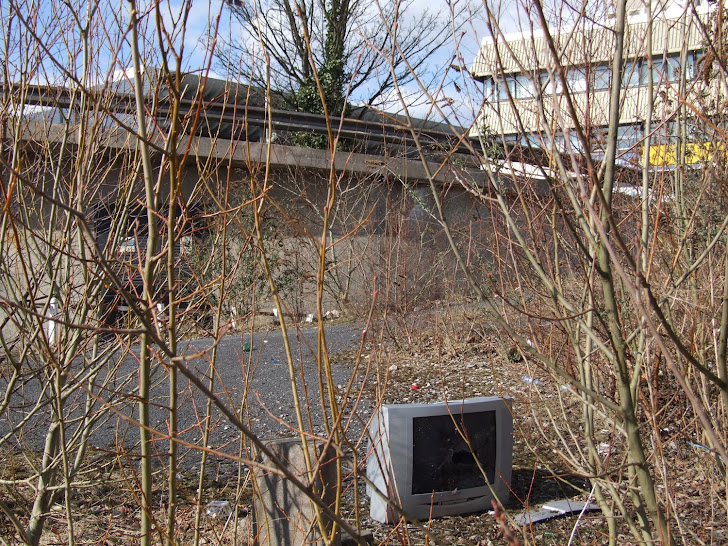Sunday 24 August 2008
TV guide
The image of the TV helping to mark out the boundary of a dug-out hole is curious and sings back to me the style of commentary that Richard Wentworth was observing in London. My partner Alizon pointed this out to me just around the corner from our house in Alhama de Granada, Spain (see blogspot for creative holidays). Obviously it means little to the people who arranged it but looking from the outside of the situation it seems comical and absurd.
Friday 9 May 2008
Fleetwood and neighbouring towns
Blackpool has always been coastal king when it comes to the attraction: seaside amusements, the Pleasure Beach, tat and tack, the promenade and piers and of course the Tower. Morecambe seems more subdued and melancholic although the town awaits an influx of visitors as the fantastically re-vamped Art Deco Midland hotel rises again and the town's biggest focus right now - the Eden Project, is stirring interest as it looms on the Bay's horizon. Morecambe's Vintage weekend is a great crowd puller too in September.
I really like Morecambe while Southport, at least to me, feels more like the posher end of northern seaside culture with its outsiderness from Liverpool, the Victorian shop fronts. (All towns should have the same styled canopies to stop the battering rain).
Fleetwood on the other hand is a place that Lancashire seems has forgotten about. Its better fishery days long gone, its pier gone, a line of squat shops selling sun-bleached postcards and garish stuff for kids. As ever I'm drawn to these fringe towns and their awkward spaces. People wander about on the 'proms', couples nest in the dunes, while others sit in their cars and watch the sea, with their chips.
I really like Morecambe while Southport, at least to me, feels more like the posher end of northern seaside culture with its outsiderness from Liverpool, the Victorian shop fronts. (All towns should have the same styled canopies to stop the battering rain).
Fleetwood on the other hand is a place that Lancashire seems has forgotten about. Its better fishery days long gone, its pier gone, a line of squat shops selling sun-bleached postcards and garish stuff for kids. As ever I'm drawn to these fringe towns and their awkward spaces. People wander about on the 'proms', couples nest in the dunes, while others sit in their cars and watch the sea, with their chips.
They have a tram day in Fleetwood and no one can be bothered. The song Everyday is like Sunday springs to mind, which is unfair because rumour was the song was about everywhere else - Morecambe, Southport, Hartlepool, and actually filmed in Southend-on-Sea. We're left with rumour and unknowing which adds to these windswept coastal towns.
Monday 28 April 2008
Non-place and uncertain spaces
Psychogeography is a good companion to the random thinking flaneur who wanders with a camera. I've always been drawn to marginal places and spaces. Photography is an absolute passion and the timing of the shutter firing fits my own attention span on the world. The urban experience is different to me everyday. Saying that, I do have interests that are central to the city and its edges. What sometimes seems like aimless wandering is justified by this random mapping - finding material subjects that fit the projects I concentrate on, such as ruin, wasteground, non-places, textures, walls, palimpsests, odd wording, letters, objects on the ground, the list goes on. Robert Frank once said 'you can photograph anything these days'. Its true, and most people are photographers as well. But its how you collate, edit' and present work that helps a working photographer to find an interested audience.
Beyond the spaces of ruin and wastelands that often lay forgotten are the evergrowing number of new buildings, the shining glass exteriors of offices and group companies that are like mini-mirrors of beast capitals like Bejing and Tokyo, New York and London. At the city fringes, along side the dead garages and waste grounds are the non-place (a name coined by French philosopher and anthropologist Marc Auge). These new filled spaces are transitory states through which we move through - often very slowly and mechanically, for transactional and security purposes: airports, retail parks, ATM queues, the new 'malls' and peripheral supermarkets. There are dozens of other examples of non-places. A recent photograph I took shows a sample of a new 'exclusive home zone'(see Lytham below). Near to this was a 'Marketing Suite' where flags waved proudly on clipped lawns and not a soul in sight. These are the cold-edged marginal spaces within their own worlds, disconnected to ruins and places of history and identity. Months before (and left for years)this was a wasteland where people walked.
Beyond the spaces of ruin and wastelands that often lay forgotten are the evergrowing number of new buildings, the shining glass exteriors of offices and group companies that are like mini-mirrors of beast capitals like Bejing and Tokyo, New York and London. At the city fringes, along side the dead garages and waste grounds are the non-place (a name coined by French philosopher and anthropologist Marc Auge). These new filled spaces are transitory states through which we move through - often very slowly and mechanically, for transactional and security purposes: airports, retail parks, ATM queues, the new 'malls' and peripheral supermarkets. There are dozens of other examples of non-places. A recent photograph I took shows a sample of a new 'exclusive home zone'(see Lytham below). Near to this was a 'Marketing Suite' where flags waved proudly on clipped lawns and not a soul in sight. These are the cold-edged marginal spaces within their own worlds, disconnected to ruins and places of history and identity. Months before (and left for years)this was a wasteland where people walked.
Monday 24 March 2008
The absurd
In the photographs of the artist Richard Wentworth he observes our daily eccentricities in and about the streets of London and beyond. His Making Do and Getting By study looks at ordinary things that suddenly become quirky or much more odder, now that they are turned into photographs. They are singular gestures such as propping up an old flaky window with a coffee mug or placing a polystyrene cup on a spiky railing.
Although his work has informed me about our strange ways, the type of photographs that I am taking tends to be within the region I live in Lancashire in the North West. The information I want to gather is similar in visual tones but the messages are slightly different and more to do with the ridiculous than the sublime, and more with absurdity than resourcefulness and making-do.
Sometimes the surrealism leans in too. This is an area where many photographers of the past can be aligned. Surrealism has been suggested into Eugene Atget’s photography, Andre Kertesz’s, Henri Cartier-Bresson’s and dozens of others throughout the 20th Century. It’s a deeper subject that swamps the darker recesses of reality and too sprawling for me to be a master of its text but its also personal and viewed through a camera can create some strange and mixed communications.
Weird images may be strange but does that mean the photographer is strange? For instance, the Shop Window taken in Southport is, in part, an unconscious array of gifts gathered to sell. But as an image it doesn’t really make me want to buy, apart from not being an Alsatian, Elvis or Victorian scary doll fan. It’s the combination of these things, well that and the dog’s tongue, that make it darkly comic. Ironically, it’s probably not a photograph you’d want on your wall either.
Although his work has informed me about our strange ways, the type of photographs that I am taking tends to be within the region I live in Lancashire in the North West. The information I want to gather is similar in visual tones but the messages are slightly different and more to do with the ridiculous than the sublime, and more with absurdity than resourcefulness and making-do.
Sometimes the surrealism leans in too. This is an area where many photographers of the past can be aligned. Surrealism has been suggested into Eugene Atget’s photography, Andre Kertesz’s, Henri Cartier-Bresson’s and dozens of others throughout the 20th Century. It’s a deeper subject that swamps the darker recesses of reality and too sprawling for me to be a master of its text but its also personal and viewed through a camera can create some strange and mixed communications.
Weird images may be strange but does that mean the photographer is strange? For instance, the Shop Window taken in Southport is, in part, an unconscious array of gifts gathered to sell. But as an image it doesn’t really make me want to buy, apart from not being an Alsatian, Elvis or Victorian scary doll fan. It’s the combination of these things, well that and the dog’s tongue, that make it darkly comic. Ironically, it’s probably not a photograph you’d want on your wall either.
Saturday 22 March 2008
Friday 21 March 2008
Eyelevel and No borders Photography
Photography started a long time ago for me when the world seemed like it had started in black & white; Family photos, the NME, The Face magazine, record sleeves and world photojournalist and documentary features in magazine supplements, all helped to steer me into taking pictures and go for a degree (in 2006).
Subscribe to:
Posts (Atom)
Locked gates

Bridge at Vernon's

Percy St, Preston

Once: a social club
Church St tiled walls

Wasteland
